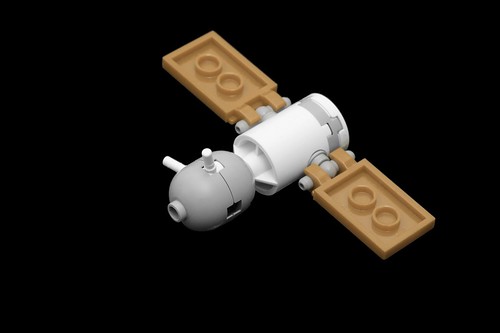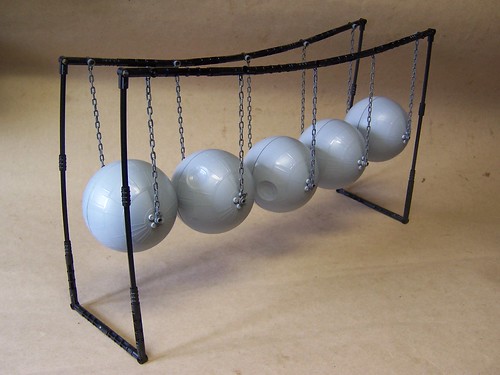
Wednesday, August 22, 2012
Newton's cradle
A Newton's cradle (here in LEGO by Monsterbrick) is a device that demonstrates the principle of the conservation of momentum. Five steel balls are suspended from a frame so that they are just touching. As the ball on the left is lifted up and let go, it swings towards the other balls. When it strikes them it stops, but that momentum has to go somewhere. It is transferred through the balls to the right hand ball, which swings out. As this reaches the top of its arch it swings back, repeating the pattern. If there were no loss of energy due to friction this could go back and forth forever.


Tuesday, August 21, 2012
Monday, August 20, 2012
Parkes Observatory
We are all familiar with optical telescopes that allow you to see magnified views of distant stars and planets. Visible light is only a small portion of the electromagnetic spectrum, though. Electromagnetic energy is a series of energies that travel as waves and they differ in their wavelength (which relates to energy). Visible light is just that section of wavelengths that our eyes can interpret. Radio is another portion of the electromagnetic spectrum with longer wavelengths (lower energies) than visible light. Stars produce energies across the electromagnetic spectrum, and to fully study them we should observe all of these different types of energy. So in addition to optical telescopes, we need other instruments. One example is the 64 meter radio telescope at the Parkes Observatory in Australia. Ross Crawford has built a couple of different LEGO versions.
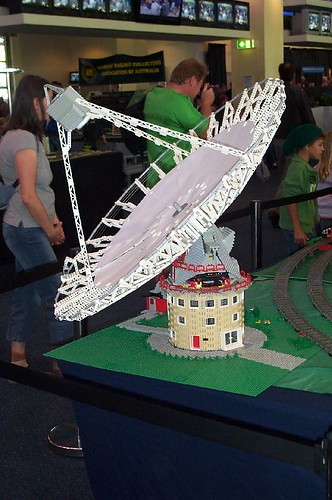



Sunday, August 19, 2012
Saturday, August 18, 2012
July 20, 1969
Legorevolution celebrated the Apollo 11 moon landing. There's so much to love about this model. In addition to the great figure, note how he did the surface of the moon, and the frame includes Armstrong's famous quote and micro versions of the Saturn V, the lunar lander and the command module.


Friday, August 17, 2012
Thursday, August 16, 2012
Pythagoras in action
LEGO is built with primarily right angles, but the Mad Physicist shows us how a little bit of math can be used to come up with all sorts of other angles. In this example he takes advantage of the pythagorean triple 8, 15, 17. That is, a triangle with a right angle and two sides that are 8 and 15 units long will have a third side that is 17 units long (he actually cuts all of these measures in half).
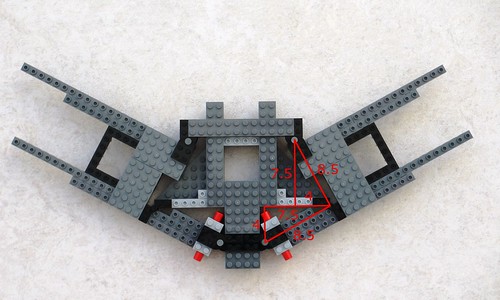
Here's another pythagorean triple, a 3, 4, 5 triangle in Technic beams by Blackbird.


Here's another pythagorean triple, a 3, 4, 5 triangle in Technic beams by Blackbird.

Wednesday, August 15, 2012
Fusion power
There's one important source that I did not cover in my recent series on energy, because it has not yet proven to be commercially viable, is nuclear fusion. Fusion is the process that occurs in stars. As small atomic nuclei fuse together to make heavier nuclei, energy is produced. Nuclear fusion could prove to be an incredible source of energy, since the fuel source, hydrogen, would be readily available from ocean water, and the byproduct, helium, is environmentally benign. Unfortunately, it has so far been difficult to contain and perpetuate the fusion reaction process. One important step in bringing the promise of fusion to fruition is the ITER reactor being built as an international cooperative project in France. So far, though, this project has run into technological, budgetary, and bureaucratic problems, as described in a recent Scientific American article. That article was illustrated with a LEGO model of the ITER reactor by Sachiko Akinaga, and the Scientific American blog has more photos.


Tuesday, August 14, 2012
Monday, August 13, 2012
Sunday, August 12, 2012
Kennedy Space Center
Teazza created this amazing version of Launch Complex 39-A (including his shuttle Crawler-Transport) and the Vehicle Assembly Building.




Friday, August 10, 2012
Sylvia Earle
Sylvia Earle is one of the world's leading oceanographers, having led more than 60 scientific expeditions with over 7000 hours underwater. Pixbymaia has made a LEGO version of Dr. Earle and even had the opportunity to pose with the original.
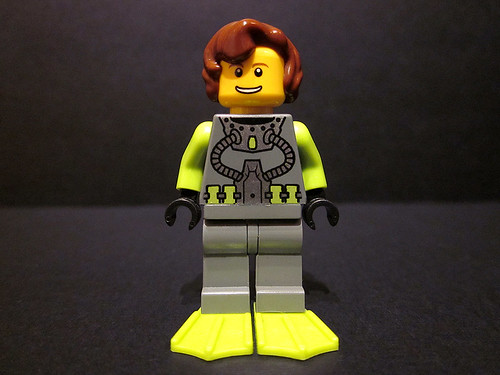
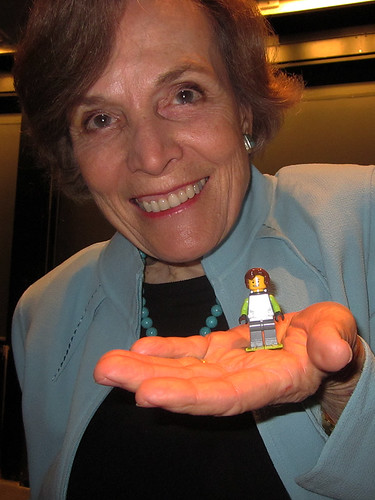


Thursday, August 9, 2012
Wednesday, August 8, 2012
Volcano
Shannon Ocean built this great cross section of a volcano. You can see how the cone was built up by successive layers of ash. At the bottom you see the magma chamber and the conduit leading up to the vent, with a dike leading off to a smaller vent on the side.


Tuesday, August 7, 2012
Solar power
All of the electricity generation discussed so far has involved turbines. Either water is heated (by burning fuel or from nuclear fission) to make steam, that turns turbines, or wind, water or waves turn the turbines directly. Solar power works on a completely different principle. In the photovoltaic effect, absorbance of light energy causes some substances to emit electrons. In a solar cell, this movement of electricity is captured as an electric current. Unfortunately, while this has great potential as a renewable resource, it is still not used very much. A couple of years ago solar accounted for 1% of US electricity and estimates suggest this will rise to 4% by 2020. Many LEGO creations, particularly futuristic ones, feature solar panels, such as Annie Corder's city,

Doctor Sinister's Aurora Station,
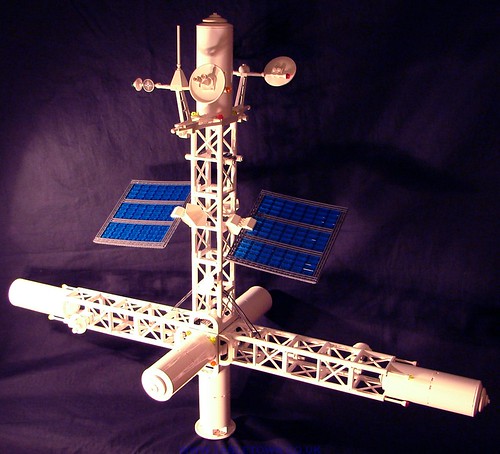
and Zg1134's WALL-E.

Here's a solar power installation from Legoland Billund.

LEGO has even made two official real solar cell elements that are used in a few of the educational Dacta sets.

Here Peter Hoh used one of them to make a solar-powered car.
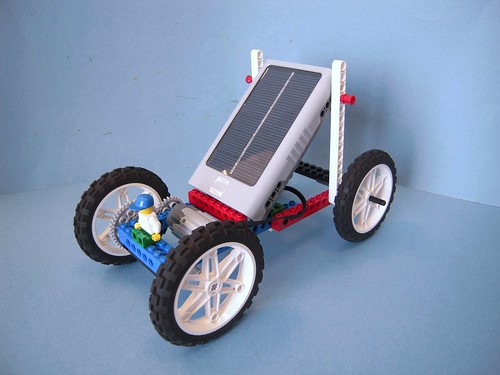
And that's it for our little foray into understanding how electricity is produced. I'll go back tomorrow to a series of more random MOCs that have popped up recently.

Doctor Sinister's Aurora Station,

and Zg1134's WALL-E.

Here's a solar power installation from Legoland Billund.

LEGO has even made two official real solar cell elements that are used in a few of the educational Dacta sets.

Here Peter Hoh used one of them to make a solar-powered car.

And that's it for our little foray into understanding how electricity is produced. I'll go back tomorrow to a series of more random MOCs that have popped up recently.
Monday, August 6, 2012
Seven minutes of terror
I'll come back to energy tomorrow, but I wanted to take a moment to congratulate the scientists and engineers at NASA on the incredible news from Mars. I'm sure if you read this blog you already picked up on this, but yesterday Curiosity landed safely on Mars. The landing used a very unique system. First a parachute helped slow down the landing vehicle, then rockets slowed down the descent stage even further, until it was left hovering about 25 feet above the surface of the planet. Then the Curiosity rover was lowered down from this 'sky crane' on cables, to touch down and roll off on its merry way. Alex Kobbs (Kooberz) made a fun video of this landing.


Sunday, August 5, 2012
LEGO and wind power
LEGO has an extensive record with wind power. In their educational Dacta line, sets like 9684, Renewable Energy and 9688, Renewable Energy Add-On help kids create science experiments to learn about wind power.

In 2008 they created an exclusive set, Vestas Wind Turbine as part of their cooperation with that company (see yesterday's post). Unfortunately for LEGO fans, that set was very limited, and only available to Vestas employees.

Probably in response to the huge AFOL interest in the exclusive Vestas set, the following year LEGO released 7747, Wind Turbine Transport.

Wind turbines have also been featured in the Legoland parks, such as here in Billund.

A larger wind farm is being built at Legoland Billund, to celebrate LEGO's billion kroner investment in a wind farm being built off the coast of Germany. The company is committed to using 100% renewable energy by 2020.

In 2008 they created an exclusive set, Vestas Wind Turbine as part of their cooperation with that company (see yesterday's post). Unfortunately for LEGO fans, that set was very limited, and only available to Vestas employees.

Probably in response to the huge AFOL interest in the exclusive Vestas set, the following year LEGO released 7747, Wind Turbine Transport.

Wind turbines have also been featured in the Legoland parks, such as here in Billund.

A larger wind farm is being built at Legoland Billund, to celebrate LEGO's billion kroner investment in a wind farm being built off the coast of Germany. The company is committed to using 100% renewable energy by 2020.
Saturday, August 4, 2012
Vestas Display
In 2009 LEGO partnered with the Danish wind power company Vestas to create a big public display that was in the Stockholm airport. I do not know if it is still there or if it was ever displayed at other locations. The different display boxes showed wind turbines being constructed and used all around the world. There was also a large house showing all the ways we use electricity, a free build section, and a giant turbine.












Friday, August 3, 2012
Wind energy
Windmills have been used for the past 2000 years to harness the energy of the wind to mill grain and pump water (MOCs by Darthtuner and MdrnMrvls, respectively).


In more recent years, wind power has been used to generate electricity. The idea is quite simple: wind turns the blades of the windmill, which spins a turbine, which generates electricity. Wind power generation is very efficient and completely renewable, though there is a large capital investment to build wind farms. Currently wind supplies about 4% of electricity used in the US, though proponents say that it could supply up to 20% by the year 2030. Several LEGO builders have made turbines, such as this micro version by Pbpancho,

this minifig scale installation by Matija,

and a three meter high version by Engineers Without Borders.

Here's a great MOC of a turbine transport by Marek Markiewicz.



In more recent years, wind power has been used to generate electricity. The idea is quite simple: wind turns the blades of the windmill, which spins a turbine, which generates electricity. Wind power generation is very efficient and completely renewable, though there is a large capital investment to build wind farms. Currently wind supplies about 4% of electricity used in the US, though proponents say that it could supply up to 20% by the year 2030. Several LEGO builders have made turbines, such as this micro version by Pbpancho,

this minifig scale installation by Matija,

and a three meter high version by Engineers Without Borders.

Here's a great MOC of a turbine transport by Marek Markiewicz.

Wednesday, August 1, 2012
Geothermal energy
Another way of generating electricity relies on the heat energy of the core of the earth. The earth's core reaches temperatures of up to 5000 degrees Celsius. This is in part left over heat from the origin of the planet, but is even more due to the decay of radioactive elements deep in the earth's core. This tremendous heat energy melts rock, which begins to rise. Most spectacularly, if this magma bursts through to the earth's surface, we see a volcano (here in LEGO by Bryce McGlone and Brandon Griffith).

If the magma does not burst through to the surface, but instead heats up groundwater, the resulting superheated steam can burst out in the form of a geyser (here in LEGO by Brother Steven).
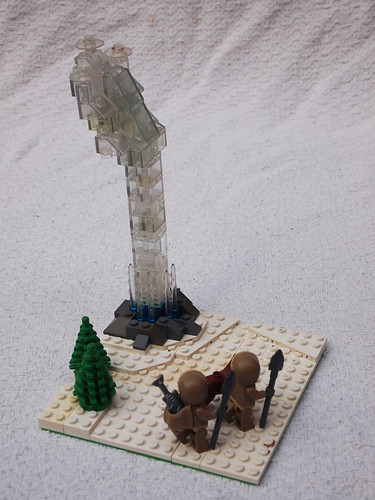
Geothermal power takes advantage of this superheated groundwater. Either the steam that is created directly turns a turbine, or its heat is used to vaporize a secondary liquid that then turns a turbine. In either case, this then generates electricity. MyGreenHosting made 'a LEGO set we'd like to see': geothermal powered data center. MyGreenHosting is an Icelandic web hosting company that promotes itself as environmentally friendly because they are completely powered by geothermal and hydroelectric energy.

Geothermal electricity is efficient and nonpolluting. Unfortunately, it is very limited in application because it requires very specific geological conditions. For instance, it only accounts for 0.3% of US power. Iceland is the Saudi Arabia of geothermal, with 30% of their electricity coming from geothermal. The Phillipines, El Salvador, Costa Rica, Kenya, Nicaragua and New Zealand are other countries with at least 10% of their electricity coming from geothermal.

If the magma does not burst through to the surface, but instead heats up groundwater, the resulting superheated steam can burst out in the form of a geyser (here in LEGO by Brother Steven).

Geothermal power takes advantage of this superheated groundwater. Either the steam that is created directly turns a turbine, or its heat is used to vaporize a secondary liquid that then turns a turbine. In either case, this then generates electricity. MyGreenHosting made 'a LEGO set we'd like to see': geothermal powered data center. MyGreenHosting is an Icelandic web hosting company that promotes itself as environmentally friendly because they are completely powered by geothermal and hydroelectric energy.

Geothermal electricity is efficient and nonpolluting. Unfortunately, it is very limited in application because it requires very specific geological conditions. For instance, it only accounts for 0.3% of US power. Iceland is the Saudi Arabia of geothermal, with 30% of their electricity coming from geothermal. The Phillipines, El Salvador, Costa Rica, Kenya, Nicaragua and New Zealand are other countries with at least 10% of their electricity coming from geothermal.
Subscribe to:
Posts (Atom)





